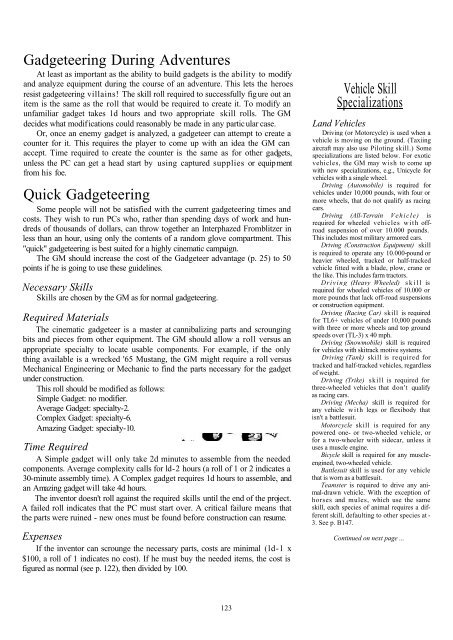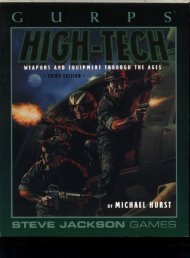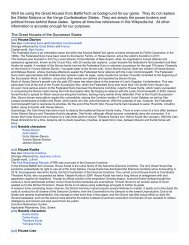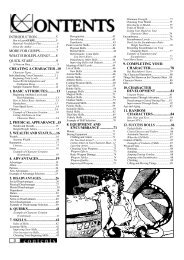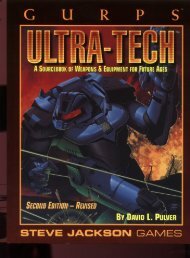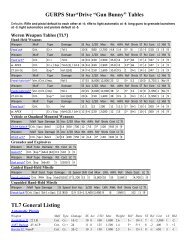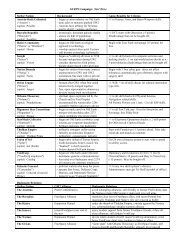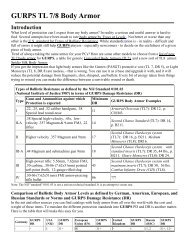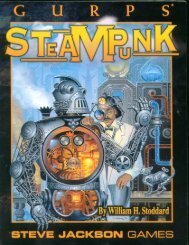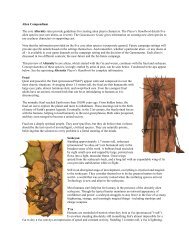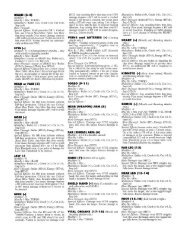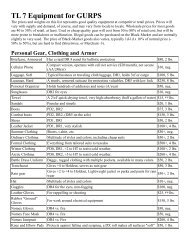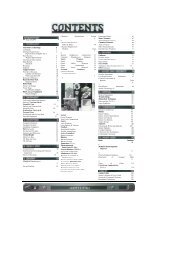GURPS - Compendium 1..
GURPS - Compendium 1..
GURPS - Compendium 1..
You also want an ePaper? Increase the reach of your titles
YUMPU automatically turns print PDFs into web optimized ePapers that Google loves.
Gadgeteering During Adventures<br />
At least as important as the ability to build gadgets is the ability to modify<br />
and analyze equipment during the course of an adventure. This lets the heroes<br />
resist gadgeteering villains! The skill roll required to successfully figure out an<br />
item is the same as the roll that would be required to create it. To modify an<br />
unfamiliar gadget takes 1d hours and two appropriate skill rolls. The GM<br />
decides what modifications could reasonably be made in any particular case.<br />
Or, once an enemy gadget is analyzed, a gadgeteer can attempt to create a<br />
counter for it. This requires the player to come up with an idea the GM can<br />
accept. Time required to create the counter is the same as for other gadgets,<br />
unless the PC can get a head start by using captured supplies or equipment<br />
from his foe.<br />
Quick Gadgeteering<br />
Some people will not be satisfied with the current gadgeteering times and<br />
costs. They wish to run PCs who, rather than spending days of work and hundreds<br />
of thousands of dollars, can throw together an Interphazed Fromblitzer in<br />
less than an hour, using only the contents of a random glove compartment. This<br />
"quick" gadgeteering is best suited for a highly cinematic campaign.<br />
The GM should increase the cost of the Gadgeteer advantage (p. 25) to 50<br />
points if he is going to use these guidelines.<br />
Necessary Skills<br />
Skills are chosen by the GM as for normal gadgeteering.<br />
Required Materials<br />
The cinematic gadgeteer is a master at cannibalizing parts and scrounging<br />
bits and pieces from other equipment. The GM should allow a roll versus an<br />
appropriate specialty to locate usable components. For example, if the only<br />
thing available is a wrecked '65 Mustang, the GM might require a roll versus<br />
Mechanical Engineering or Mechanic to find the parts necessary for the gadget<br />
under construction.<br />
This roll should be modified as follows:<br />
Simple Gadget: no modifier.<br />
Average Gadget: specialty-2.<br />
Complex Gadget: specialty-6.<br />
Amazing Gadget: specialty-10.<br />
Time Required<br />
A Simple gadget will only take 2d minutes to assemble from the needed<br />
components. Average complexity calls for ld-2 hours (a roll of 1 or 2 indicates a<br />
30-minute assembly time). A Complex gadget requires 1d hours to assemble, and<br />
an Amazing gadget will take 4d hours.<br />
The inventor doesn't roll against the required skills until the end of the project.<br />
A failed roll indicates that the PC must start over. A critical failure means that<br />
the parts were ruined - new ones must be found before construction can resume.<br />
Expenses<br />
If the inventor can scrounge the necessary parts, costs are minimal (ld-1 x<br />
$100, a roll of 1 indicates no cost). If he must buy the needed items, the cost is<br />
figured as normal (see p. 122), then divided by 100.<br />
Vehicle Skill<br />
Specializations<br />
Land Vehicles<br />
Driving (or Motorcycle) is used when a<br />
vehicle is moving on the ground. (Taxiing<br />
aircraft may also use Piloting skill.) Some<br />
specializations are listed below. For exotic<br />
vehicles, the GM may wish to come up<br />
with new specializations, e.g., Unicycle for<br />
vehicles with a single wheel.<br />
Driving (Automobile) is required for<br />
vehicles under 10,000 pounds, with four or<br />
more wheels, that do not qualify as racing<br />
cars.<br />
Driving (All-Terrain Vehicle) is<br />
required for wheeled vehicles with offroad<br />
suspension of over 10.000 pounds.<br />
This includes most military armored cars.<br />
Driving (Construction Equipment) skill<br />
is required to operate any 10.000-pound or<br />
heavier wheeled, tracked or half-tracked<br />
vehicle fitted with a blade, plow, crane or<br />
the like. This includes farm tractors.<br />
Driving (Heavy Wheeled) skill is<br />
required for wheeled vehicles of 10.000 or<br />
more pounds that lack off-road suspensions<br />
or construction equipment.<br />
Driving (Racing Car) skill is required<br />
for TL6+ vehicles of under 10,000 pounds<br />
with three or more wheels and top ground<br />
speeds over (TL-3) x 40 mph.<br />
Driving (Snowmobile) skill is required<br />
for vehicles with skitrack motive systems.<br />
Driving (Tank) skill is required for<br />
tracked and half-tracked vehicles, regardless<br />
of weight.<br />
Driving (Trike) skill is required for<br />
three-wheeled vehicles that don't qualify<br />
as racing cars.<br />
Driving (Mecha) skill is required for<br />
any vehicle with legs or flexibody that<br />
isn't a battlesuit.<br />
Motorcycle skill is required for any<br />
powered one- or two-wheeled vehicle, or<br />
for a two-wheeler with sidecar, unless it<br />
uses a muscle engine.<br />
Bicycle skill is required for any muscleengined,<br />
two-wheeled vehicle.<br />
Battlesuit skill is used for any vehicle<br />
that is worn as a battlesuit.<br />
Teamster is required to drive any animal-drawn<br />
vehicle. With the exception of<br />
horses and mules, which use the same<br />
skill, each species of animal requires a different<br />
skill, defaulting to other species at -<br />
3. See p. B147.<br />
Continued on next page ...<br />
123


